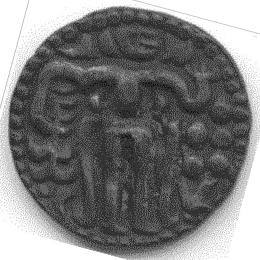
| Majority of the coins issued have an obverse impression of a standing figure of a man with head turned to the right and with two curved lines on either side of the legs slightly turned upwards at the end indicating the figure is wearing a 'dhoti'. The figure stands on a lotus stem or stalk with a lotus flower to the right. Above the flower there appears five large dots or spheres each of which varies in~size. The right side elbow is curved down with the arm turned upwards and the hand holds a flower presumed to be a jasmine blossom. The left arm is extended outwards and curved downwards holding an ornamental lamp. Behind the head of the figure are two crescent like shapes At the rim of the coin there appears to be 40 to 43 beads. |

|
A cursory glance at the reverse of such coins may also indicate that most coins of the period of the Sinhala Monarch were minted to a set pattern. The design on the reverse resembles a figure of a man in a seated or in a squatting position with the right leg drawn up under the right arm. The left arm is raised upwards and 'the hand holds a conch shell, Behind the head above the right arm are two crescent/shaped designs, Around the rim of the coin as in the obverse runs a row of beads. On the left side of the coin deva-nagari or Sanskrit script is visible which indicates the name of the ruler.
Almost all Sanskrit characters appearing on the reverse of coins of the Sinhala Monarchs seem to vary very slightly from each other to the layman, In deciphering Sanskrit characters adequate allowance should be given to wear and tear of coins of a bygone era, the crude methods of early minting of coins and the slight changes in the Sanskrit characters from one period to another. Out of the many Monarchs who ruled the island only nine rulers are associated with their names on coins. The coins issued during the reigns of king Vijaya Bahu I, II, III & IV and of king Parakrama Bahu I & II have similar Sanskrit characters on them and therefore, identification by such script alone is difficult, The same applies to queen Lilavati, her first, second and third reigns are identical in terms of the deva~nagari characters appearing on coins.
The six more common Massa coins that are found in Lanka
were issued by the Monarchs during two periods in the 13th century
The period saw the decline of Polonnaruwa era and the move of
the capitol to Dambadeniya and later to Yapahuwa.
For images of the reverse side of the massa coins
1197-1211 Late Polonnaruva period coins
1236-1283 Dambadeniya period coins
A book titled "Kandy Kings of Ceylon 1055-1295 CE. published by Frank
A Lapa, about these coins has perpetuated in US the erroneous names
"Kandy Kings" for these coins which are not associated with Kandy,
which became the capitol of Lanka only in 1590 and at times "monkey
money" although they don't depict the mythical god "Hanuman".
I keep telling eBay sellers not refer to Lankan Monarchs as monkeys.
Lapa's preface mentions the correct lankan name "Dambadeni Kasi" for these coppers. The origin of the error in name, can be traced to much older numismatic artcles in the mid 19th century when the history of Lanka was less well known.
Text edited from Currency Museum Circular No 6
Issued by the Currency Department, Central Bank of Ceylon on 31 January 1984
Click for Lanka coin Home Page.